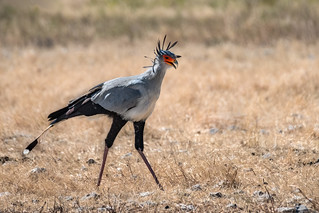[Population] Cave Bear Model!
This is our first AP for this trimester's STEAM course! It is called Population and we have been diving into scientific language, taxonomy, and sets. For this AP, we have been tasked with building a model of an organism of our choosing and saying a little bit about the taxonomic levels of the organism. I chose Cave Bears or Ursus spelaeus. Cave Bears were a species of bear that went extinct about 24,000 years ago. They lived in mostly northern Europe, ranging from Great Britain to Western Russia, going about as far south as Northan Iran. They were not, however, found in places that were heavily filled with glaciers, like Scotland. They ate mostly plants, which is surprising for their massive size. Cave Bears stood at an impressive two meters on all four legs and three meters when on their hind legs, as well as being equipped with sharp claws that would be perfect for taking down the large megafauna that existed during that time period. Their teeth would suggest, however, that they enjoyed a mostly vegetarian diet. They were not herbivorous, however, as animal protein has been found in dung. In fact, it would seem they would often partake in cannibalism, perhaps taking advantage of fellow Cave Bears freezing to death during the winter. It is not entirely clear why Cave Bears went extinct. It almost certainly wasn’t human interference like most ice age megafauna, as the human populations in the area of northern Europe where the Cave Bear lived were much too small to pose a threat to the wider population. Climate Change also isn’t likely the reason, as they disappeared a few thousand years before the ice melted. It remains one of science’s greatest mysteries and the reason may never be uncovered.

A Cave Bear
Here are the taxonomic levels of the Cave Bear:
1.
This organism is a Cave Bear. It is a part of the kingdom of Animalia. This is shown by the fact that it is multicellular, breathes oxygen, can move, etc.
2.
It is also a Chordate. The easiest way to tell this is by the fact it has a tail that extends behind the anus, even though on bears that tail is relatively quite small.
3.
The Cave Bear is also a Mammal. This is shown by the fact that the females produce milk to feed their young, and they give live birth.
4.
Cave Bears are in the order of Carnivora. It specializes in eating meat, although is not restricted to only meat. In fact, Cave Bears would often take advantage of the vegetarian options available to them.
5.
Cave Bears are in the family of Ursidae. This means they are a bear and are recognizable by their large bodies with stocky legs, long snouts, small rounded ears, shaggy hair, plantigrade paws (Walking with all of their foot) with five nonretractile claws, and short tails.
6.
The Cave Bear is part of the genus, Ursus. This includes Brown Bears, Polar Bears, Asian, and American Black Bears, as well as, of course, Cave Bears. They are often larger and more carnivorous than other species of bear, like the Giant Panda.
7.
And finally, we are down to the species. Spelaeus. They were first recorded in 1774 by Johann Friedrich Esper in his book Newly Discovered Zoolites of Unknown Four Footed Animals. Scientists pondered what the fossils discovered could be, with the lead theory being a massive Polar Bear, as bears this big didn’t exist. Eventually, as technology advanced, Scientists figured out it its own species of bear. And with that, the genus and species were combined to create Ursus Spelaeus.




My Model - The one standing on all two legs is Janice and the one standing on four is Jeremy
This model shows two cave bears, one standing on its hind legs and one standing on all four. It shows most of the physical features, like claws, teeth, ears, muzzle, and eyes. It also explains all the taxonomic levels.
Venn Diagram and Sets:

These three organisms are very interesting because all three of them were megafauna from the ice age. Cave Bears lived in caves, were omnivores, are a part of Carnivora, and have been extinct for 24,000 years while Megatherium, was part of Pilosa and ent extinct 12,000 years ago, and Mammoths had tusks, were a part of Proboscidea, and have only been extinct for 4,000 years. Both Megatherium and Mammoths were Herbivores. Both Megatherium and Cave Bears were capable of bipedalism for a limited time. Both Cave Bears and Mammoths have a close surviving relative to this day, where's Megatherium only has tree sloths, which are very far from it's greatness.
Carnivora ∈ Cave Bears - Carnivora is an element of Cave Bears
Herbivore ∩ Megatherium and Mammoths - Herbivora is an element of Megatherium and Mammoths
Cave Bear ∈ Megafauna\Herbivores - Cave bear is an element of Megafaune but not Herbivores
Cave bear ∪ Megatherium={Lived in caves, Omnivore, Carnivora, Extinct for 24,000 years, Close surviving relative, Ice Age Megafauna, Herbivore, Claws, Pilosa, Extinct for 12,000 years, Capable of limited bipedalism} - Lived in caves, Omnivore, Carnivora, Extinct for 24,000 years, Close surviving relative, Ice Age Megafauna, Herbivore, Claws, Pilosa, Extinct for 12,000 years, Capable of limited bipedalism are in the union of Cave Bear and Megatherium
Tusks ∈ Mammoths - Tusks are an element of Mammoths
This AP has been a very good representation of all that we have been working on in this unit. It uses all the taxonomic levels and classifies an animal, it uses scientific language, and it uses set theory. Plus, it was very fun to create Janice and Jeremy. All in all, I believe this to be a very successful action project.

Comments
Post a Comment